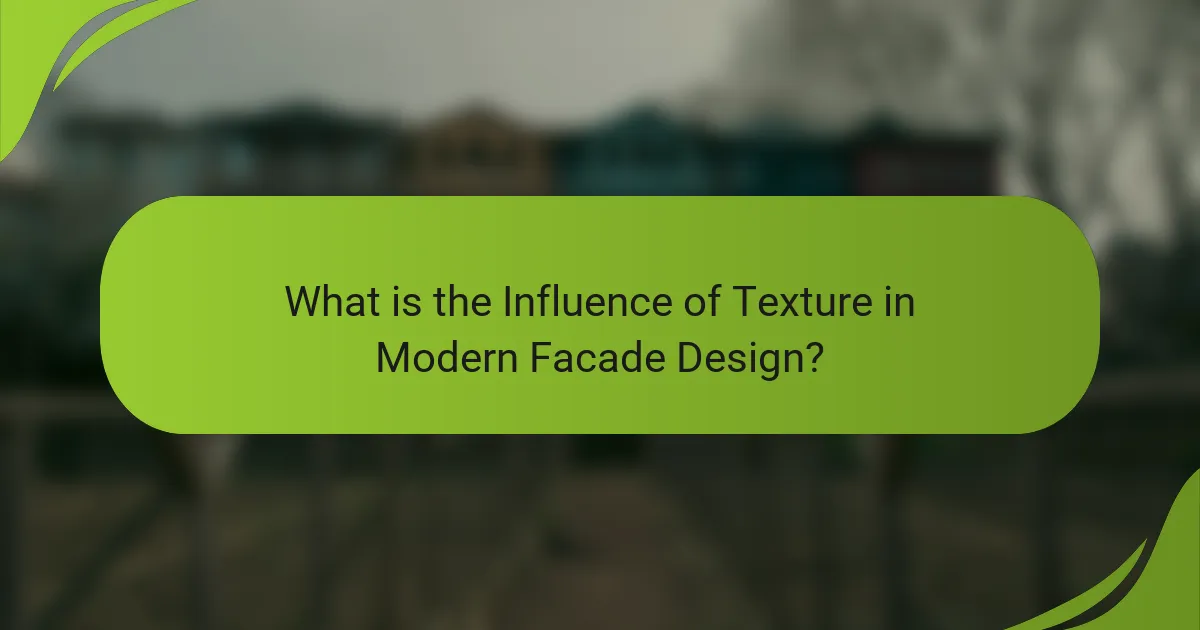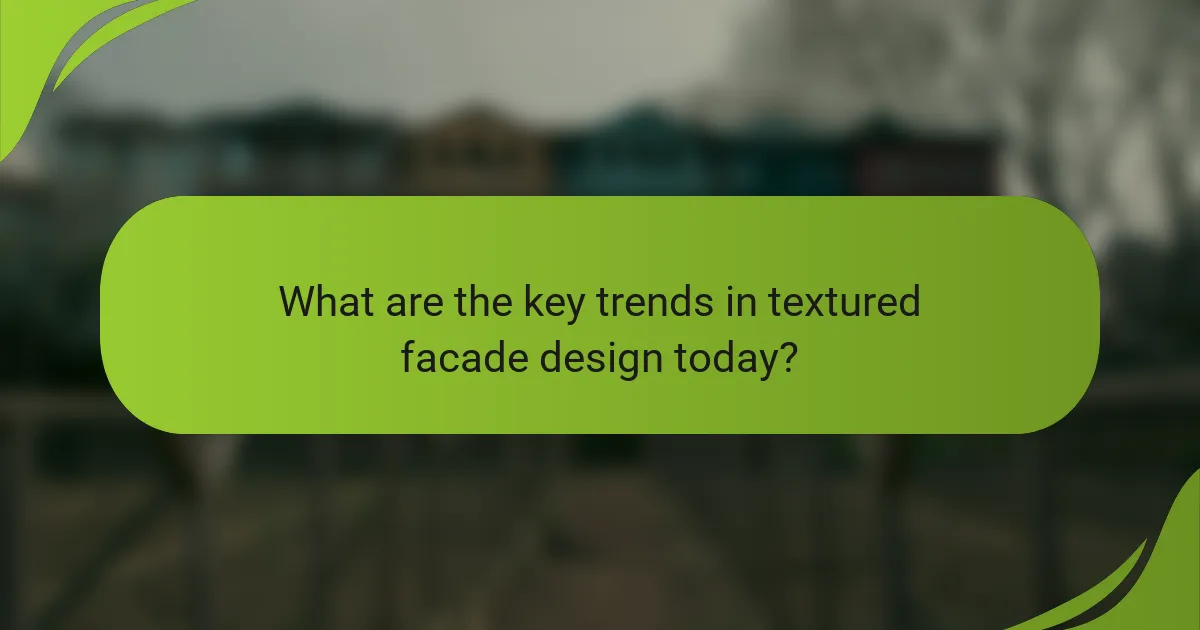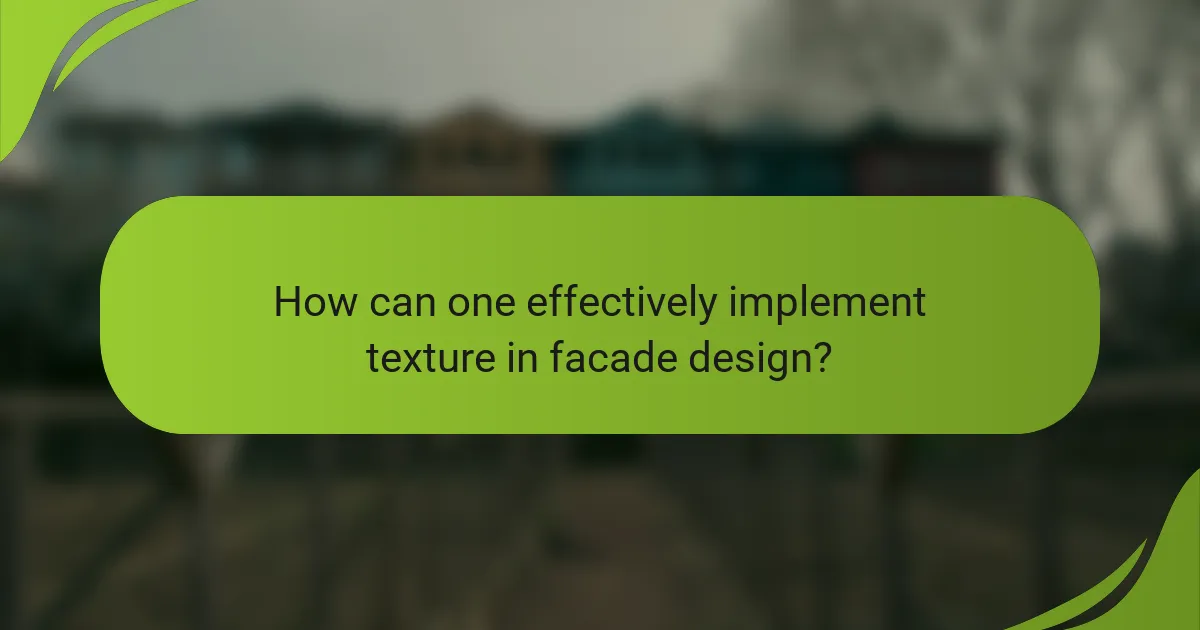Texture is a critical element in modern facade design, influencing both aesthetic appeal and functionality. It affects light interaction, emotional perception, and contributes to sustainability through improved insulation and acoustics. Current trends highlight the use of natural materials, innovative technologies like 3D printing, and sustainable practices, emphasizing a blend of textures for visual interest. Effective implementation of texture involves utilizing various materials, layering techniques, and color contrasts, enhancing both the architectural style and property value. This article explores the significant role of texture in facade design, detailing its impact on user experience and engagement.

What is the Influence of Texture in Modern Facade Design?
Texture significantly influences modern facade design by enhancing aesthetic appeal and functionality. It affects how surfaces interact with light and shadow. Various textures can evoke different emotions and perceptions. For instance, smooth surfaces may convey sleekness, while rough textures can suggest warmth and organic qualities. Texture also plays a role in sustainability. Textured facades can improve insulation and energy efficiency. They can also influence acoustics, contributing to a building’s sound performance. Recent trends show a preference for mixed materials, combining textures for visual interest. Research indicates that texture can enhance user experience and engagement with buildings.
How does texture impact the visual appeal of facades?
Texture significantly impacts the visual appeal of facades by adding depth and interest. Varied textures can create contrasts that enhance a building’s aesthetic. For instance, a smooth surface may convey elegance, while rough textures can evoke a sense of ruggedness. The interplay of light and shadow on textured surfaces further accentuates visual dynamics. Studies show that buildings with textured facades are often perceived as more attractive. Research indicates that texture influences viewer emotions and engagement with the structure. This correlation underscores the importance of texture in architectural design. Thus, texture plays a crucial role in shaping the overall perception of facades.
What are the different types of textures commonly used in facade design?
The different types of textures commonly used in facade design include smooth, rough, patterned, and layered textures. Smooth textures create a sleek appearance, often using materials like glass or polished stone. Rough textures, such as exposed concrete or brick, add a tactile quality and visual interest. Patterned textures involve designs that can be achieved through materials like perforated metal or decorative panels. Layered textures create depth and dimension, often using materials like wood or composite cladding. Each texture contributes to the overall aesthetic and functionality of the building facade.
How do textures contribute to the overall aesthetic of a building?
Textures significantly enhance the overall aesthetic of a building by adding depth and visual interest. They create a tactile quality that engages viewers and invites exploration. Different textures can evoke various emotions and responses. For instance, rough textures may convey strength and durability, while smooth surfaces often suggest elegance and modernity. Textures also play a crucial role in light interaction. They can reflect, absorb, or diffuse light, affecting how a building appears at different times of day. The use of contrasting textures can create dynamic visual compositions. Historical examples, such as the use of brick versus glass in modern architecture, illustrate how texture influences perception. Ultimately, textures are essential in defining a building’s character and style.
Why is texture important in modern architecture?
Texture is important in modern architecture because it enhances visual interest and creates depth. It influences how surfaces interact with light, affecting the overall aesthetic. Textured materials can evoke different emotions and experiences for occupants and passersby. For instance, rough surfaces may convey strength, while smooth finishes suggest sleekness.
Moreover, texture contributes to the building’s functionality. It can improve insulation and reduce noise. In addition, textures can be strategically used to define spaces and guide movement. Studies show that buildings with varied textures are often perceived as more inviting and engaging.
Architectural textures also play a role in sustainability. Materials with natural textures can minimize the need for artificial lighting. This aligns with eco-friendly design principles. Overall, texture is a key component in creating modern architectural identities.
What role does texture play in the perception of building materials?
Texture significantly influences the perception of building materials. It affects aesthetic appeal, tactile experience, and emotional response. Different textures can convey warmth, coolness, or sophistication. For instance, rough textures may evoke a sense of ruggedness, while smooth surfaces often suggest modernity. Research indicates that texture impacts how materials are evaluated in terms of quality and durability. A study by K. K. H. Lee and A. K. K. Wong found that textured surfaces are perceived as more visually interesting. This perception can influence consumer choices and architectural design decisions. Thus, texture plays a crucial role in shaping the overall impression of building materials.
How does texture enhance the functionality of facades?
Texture enhances the functionality of facades by influencing aesthetics, durability, and performance. Different textures can create visual interest and depth, making buildings more appealing. Textured surfaces can also improve weather resistance by reducing water retention and preventing damage. Additionally, certain textures can enhance insulation properties, contributing to energy efficiency. For example, rough textures can create air pockets that improve thermal performance. Moreover, textures can aid in sound insulation, reducing noise pollution. Overall, the strategic use of texture in facade design leads to improved functionality and sustainability.
How does texture influence sustainability in facade design?
Texture influences sustainability in facade design by affecting energy efficiency, material usage, and maintenance. Textured surfaces can enhance thermal performance by creating microclimates that reduce heat gain and loss. This leads to lower energy consumption for heating and cooling. Additionally, textures can minimize the need for synthetic coatings, promoting the use of natural materials. Natural materials often have a lower environmental impact over their lifecycle. Furthermore, textured facades can reduce maintenance frequency by hiding dirt and wear, extending the lifespan of the building materials. Research indicates that buildings with effective texture designs can achieve up to 30% energy savings compared to smooth facades.
What are the environmental benefits of using textured materials?
Textured materials provide significant environmental benefits. They enhance energy efficiency by improving insulation properties. This reduces the need for heating and cooling, leading to lower energy consumption. Textured surfaces can also promote rainwater runoff management. They can help in reducing urban heat islands by reflecting sunlight. Additionally, these materials often use sustainable resources, minimizing environmental impact. Their durability contributes to longer life cycles, reducing waste. Studies show that textured facades can decrease energy use by up to 30%. This makes them an eco-friendly choice in modern facade design.
How can texture improve energy efficiency in buildings?
Texture can improve energy efficiency in buildings by influencing heat transfer and insulation properties. Textured surfaces can create microclimates that enhance thermal performance. For instance, rough textures can trap air, providing better insulation. This can reduce heating and cooling demands. Studies show that buildings with textured facades can achieve up to 20% energy savings. Additionally, textures can enhance solar shading, lowering heat gain in warmer months. Effective use of texture contributes to overall energy efficiency in architectural design.

What are the key trends in textured facade design today?
Key trends in textured facade design today include the use of natural materials, innovative technologies, and sustainable practices. Natural materials like wood and stone are increasingly favored for their aesthetic appeal and environmental benefits. Innovative technologies such as 3D printing allow for unique textures and patterns that enhance visual interest. Sustainable practices are driving the use of recycled materials and energy-efficient designs. Additionally, biophilic design principles are being integrated, promoting a connection between buildings and nature. These trends reflect a growing emphasis on aesthetics, functionality, and environmental responsibility in modern architecture.
How are architects incorporating texture into contemporary designs?
Architects are incorporating texture into contemporary designs through various innovative techniques. They use materials such as wood, stone, and metal to create tactile surfaces. These materials can vary in finish, from smooth to rough, enhancing visual interest. Textured facades can also influence light and shadow, adding depth to structures. For instance, the use of perforated metal panels allows for dynamic light play throughout the day. Additionally, architects often integrate green elements, like living walls, which introduce organic texture. This approach not only beautifies but also promotes sustainability. Recent projects showcase these trends, reflecting a shift toward more engaging and sensory-rich environments.
What innovative materials are being used for textured facades?
Innovative materials used for textured facades include high-performance concrete, metal panels, and fiber-reinforced polymers. High-performance concrete allows for intricate designs and durability. Metal panels offer versatility in texture and finish, enhancing aesthetic appeal. Fiber-reinforced polymers provide lightweight options with complex shapes. These materials contribute to energy efficiency and sustainability in modern architecture. Their application reflects advancements in construction technology and design innovation.
How does technology influence the creation of textured surfaces?
Technology significantly influences the creation of textured surfaces through advanced manufacturing techniques. Methods such as 3D printing allow for intricate designs that were previously difficult to achieve. Digital fabrication tools enable precise control over texture patterns and depths. Computer-aided design (CAD) software facilitates the visualization and modification of textures in the design phase. Materials science innovations lead to the development of new composites that enhance surface texture durability. Automated processes improve consistency in texture application across large areas. These technological advancements result in aesthetically pleasing and functional surfaces in modern facade design.
What challenges do designers face when working with textures?
Designers face several challenges when working with textures. One major challenge is achieving visual harmony. Textures must complement other design elements while maintaining their unique characteristics. Another challenge is material selection. Different materials exhibit varied texture properties, which can affect durability and maintenance. Designers also struggle with scale and proportion. Textures can appear differently depending on the size of the facade. Additionally, lighting plays a crucial role in how textures are perceived. Changes in light can alter the appearance and impact of textures. Finally, designers must consider the context of the building. The surrounding environment can influence the effectiveness of texture in facade design.
How can designers overcome issues related to maintenance of textured facades?
Designers can overcome maintenance issues related to textured facades by selecting durable materials. Using materials that resist weathering and staining is essential. Incorporating protective coatings can help maintain the facade’s appearance. Regular cleaning schedules should be established to prevent dirt accumulation. Designers can also choose textures that are less prone to damage. Implementing easy access for maintenance personnel is crucial. Utilizing modular design allows for easier repairs or replacements. Finally, educating building owners on maintenance practices ensures longevity.
What are common mistakes to avoid in textured facade design?
Common mistakes to avoid in textured facade design include neglecting material compatibility. Using incompatible materials can lead to structural issues. Another mistake is failing to consider the building’s context. A facade should harmonize with its surroundings. Overly complex textures can overwhelm the design. Simplicity often enhances aesthetic appeal. Inadequate maintenance planning is also a critical error. Textured surfaces may require more upkeep than smooth ones. Lastly, ignoring scale can distort proportions. Textures should complement the building’s size and design.

How can one effectively implement texture in facade design?
To effectively implement texture in facade design, utilize a variety of materials and finishes. Incorporating elements like wood, metal, and stone creates visual interest. Textured surfaces can enhance light interaction, producing dynamic shadows. Design patterns can be applied to surfaces to create rhythm and depth. Consider layering different textures for a multi-dimensional effect. Use color contrasts to highlight textured areas. Ensure that textures complement the overall architectural style. Research shows that textured facades can improve aesthetic appeal and increase property value.
What best practices should be followed for integrating texture in facades?
Integrating texture in facades enhances visual interest and depth. Best practices include selecting materials that complement the building’s design. Use contrasting textures to create dynamic surfaces. Ensure the texture aligns with the architectural style for coherence. Consider the scale of the texture in relation to the overall facade. Incorporate sustainable materials to promote environmental responsibility. Evaluate the maintenance needs of textured surfaces to ensure longevity. Utilize advanced technology for precise application of textures. These practices contribute to a well-designed facade that is both functional and aesthetically pleasing.
How can texture be used to enhance building identity?
Texture can enhance building identity by creating visual interest and conveying a specific character. Different textures can evoke distinct emotions and associations. For example, rough textures may suggest strength and durability, while smooth finishes can imply modernity and sophistication. Textural contrasts can also highlight architectural features and create focal points. Additionally, the use of local materials can reflect cultural identity and context. Studies have shown that buildings with varied textures are often perceived as more engaging and memorable. The incorporation of texture in facade design can significantly influence public perception and recognition of a structure.
What are the considerations for selecting textures for different climates?
Selecting textures for different climates involves evaluating thermal performance, moisture resistance, and aesthetic compatibility. Textures can influence heat absorption and insulation. For hot climates, reflective and light-colored textures are preferable. They help reduce heat gain and improve energy efficiency. In contrast, colder climates benefit from textured surfaces that enhance insulation. Textures can also affect moisture management. For humid areas, materials that resist mold and decay are essential. Additionally, textures should align with local architectural styles. This ensures visual harmony with the environment. Understanding these factors leads to effective facade design in varying climates.
What practical tips can help in choosing textures for facades?
Consider the building’s environment when choosing textures for facades. Textures should complement surrounding structures and landscape. Assess the climate to select materials that withstand local weather conditions. For instance, rough textures may suit areas with high winds, while smooth finishes can work in calmer climates. Evaluate the building’s purpose; commercial buildings may benefit from sleek, modern textures, while residential designs might favor warmer, inviting options. Incorporate sustainability by selecting eco-friendly materials with desirable textures. Research indicates that texture can influence perceptions of building quality and comfort. A study by the University of Cambridge found that varied textures enhance visual interest and engagement. Always consult with architects or designers for expert advice on texture selection.
How can one balance aesthetic appeal and functionality in textured facade design?
Balancing aesthetic appeal and functionality in textured facade design requires a strategic approach. Designers should select materials that offer both visual interest and durability. For instance, using textured concrete can enhance the visual complexity while ensuring structural integrity.
Incorporating patterns can create depth and shadow, contributing to the aesthetic without compromising functionality. Additionally, considering the building’s environment is crucial. Textures can help with thermal insulation and weather resistance, enhancing performance.
Research indicates that well-designed facades can improve energy efficiency by up to 30%. This demonstrates that aesthetic choices can align with functional benefits. Ultimately, the key lies in integrating design principles with practical requirements to achieve harmony.
What resources are available for further exploration of facade textures?
Books on architectural textures provide foundational knowledge. “Architectural Detailing: Function, Constructibility, Aesthetics” by Edward Allen and Patrick Rand is a key resource. Journals like the “Journal of Facade Design” explore contemporary applications. Online platforms such as ArchDaily and Designboom feature case studies on facade textures. Industry websites often offer webinars and workshops. Research papers from institutions like MIT and Harvard cover innovative materials and techniques. Local architecture schools may host lectures and exhibitions on facade design. These resources collectively enrich understanding of facade textures.
The main entity of this article is texture in modern facade design. The article explores how texture enhances aesthetic appeal, functionality, and sustainability in architectural facades. It discusses the impact of different textures on visual perception, emotional response, and energy efficiency, while also outlining common types of textures used in contemporary designs. Key trends, innovative materials, and best practices for incorporating texture into facades are highlighted, along with challenges designers face and practical tips for achieving a balance between aesthetics and functionality. Overall, the article provides a comprehensive overview of the significance of texture in modern architecture.